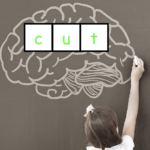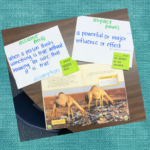* required field

Are your students citing “text evidence” without really having control of the meaning of that evidence? Do they forget to explain further or elaborate? If either of these is the case for your students, they may need to space to contemplate what one detail or quote from the text means. A simple way to do …Read more

Teaching students to identify the main ideas in a text is sometimes hard. The more explicit we can be, the better students will catch on. My key strategies for teaching main idea include the following… What follows is a description of a three-phase lesson we gave in Waukee, Iowa – a BIG THANK YOU to …Read more

Are your students glossing over important details in texts? With fiction, it’s like they get the gist of what’s going on but they don’t catch the finer details that move a story forward or that reveal critical moments. In a conference I had recently, a student was reading a Scholastic short, an excerpt from the …Read more

Are your students regurgitating facts from a text without really thinking about the big ideas being conveyed? A few weeks ago a teacher and I conferred with a student reading a book called Gorillas (Pioneer Valley series). When we asked the student, “What’s the main idea?” They shrugged. Here’s a version of what happened during …Read more

“What just happened in the story?” When a student is reading fiction, this is the question I ask first. As they respond, I begin to notice what they are NOT saying OR important details that might have been overlooked. During a recent conference, a student read the page below to me easily. The title of …Read more

A quick story about a conference I had with a young student in the early stage of reading. In just a few minutes of 1:1 conferring, she made a vital connection between word study activities and word solving while reading. It was joyous to watch! At one point she exclaimed, “Well! I have sound boxes …Read more

When reading multiple sources, noticing the author’s purpose can help a student 1) remember the content of the source and 2) begin to notice the similarities and differences between sources. I’ve created a Padlet with a text set on recycling – one for each type of author’s purpose (e.g. P.R.I.D.E.) (4th-8th grade). Please feel free …Read more

Noticing an author’s purpose helps us 1) determine what’s important in a source, 2) begin to think critically about the information in a source, and 3) remember what we read. What follows are a few recommendations for teaching “author’s purpose.” Integrate WHY into your discussions of author’s purpose The WHY of noticing an author’s purpose …Read more

I just spent seven weeks on the road working with so many amazing teachers. We spent a lot of time talking about how to teach vocabulary and there were a lot of important (and reoccurring) questions like: How do I choose words? How do I do more than cover the new vocabulary? How do I …Read more
I haven’t posted since February so it seems weird to say I’m taking a break for the summer. I’ve just been immersed in fabulous work in four school districts this spring, loving every minute and not finding the time (or energy) to blog. Recommitting this summer. Thanks for your support! See you in August.